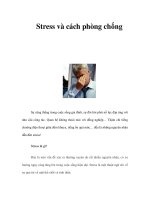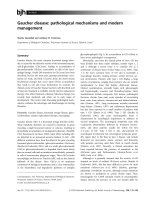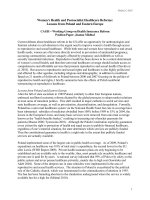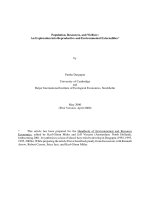Stress, Strain, and Structural Dynamics ppt
Bạn đang xem bản rút gọn của tài liệu. Xem và tải ngay bản đầy đủ của tài liệu tại đây (40.38 MB, 961 trang )
Stress, Strain, and
Structural Dynamics
The author and publisher of this book have used their best efforts in preparing this book.
These efforts include the development, research, and testing of the theories and programs
to determine their effectiveness. The author and publisher make no warranty of any kind,
expressed or implied, with regard to these programs or the documentation contained in this
book. The author and publisher shall not be liable in any event for incidental or consequential
damages in connection with, or arising out of, the furnishing, performance, or use of these
programs and/or the documentation.
MATLAB is a registered trademark of The Mathworks, Inc.
Stress,
Strain, and
Structural Dynamics
An Interactive Handbook of Formulas,
Solutions, and MATLAB Toolboxes
Bingen Yang
University of Southern California
Amsterdam Boston Heidelberg London New York Oxford
Paris San Diego San Francisco Singapore Sydney Tokyo
Elsevier Academic Press
30 Corporate Drive, Suite 400, Burlington, MA
01803,
USA
525 B Street, Suite 1900, San Diego, California 92101-4495, USA
84 Theobald's Road, London WC1X 8RR, UK
This book is printed on acid-free paper. ©
Copyright © 2005, Elsevier Inc. All rights reserved.
No part of this publication may be reproduced or transmitted in any form or by any means, electronic or
mechanical, including photocopy, recording, or any information storage and retrieval system, without
permission in writing from the publisher.
Permissions may be sought directly from Elsevier's Science & Technology Rights Department in
Oxford, UK: phone: (+44) 1865 843830, fax: (+44) 1865 853333, e-mail:
You may also complete your request online via the Elsevier homepage
(), by selecting "Customer Support" and then "Obtaining Permissions."
Library of Congress Cataloging-in-Publication Data
Yang, Bingen.
Stress, strain, and structural dynamics.
p.
cm.
Includes bibliographical references.
1.
Strains and stresses. 2. Structural dynamics. I. Title.
TA648.3.Y36 2004
624.1'7-dc22
2004022861
British Library Cataloguing in Publication Data
A catalogue record for this book is available from the British Library
ISBN: 0-12-787767-3
For all information on all Elsevier Academic Press publications
visit our Web site at www.books.elsevier.com
Printed in the United States of America
05 06 07 08 09 10 9 8 7 6 5 4 3 2 1
Working together to grow
libraries in developing countries
www.elsevier.com | www.bookaid.org | www.sabre.org
To
my parents,
My wife Haiyan, and
My daughters Sonia and
Tanya
This Page Intentionally Left Blank
Contents
Preface xv
Acknowledgements xvii
Chapter 1 Introduction 1
1.1 The Making of This Book 1
1.2 How to Use This Book 4
Part I Strength of Materials 7
Chapter 2
Chapter 3
Static Analysis of Euler-Bernoulli Beams
2.1
2.2
2.3
2.4
2.5
2.6
Getting Started
Beam Theory
2.2.1 Static Problem
2.2.2 Solution Methods
2.2.3 Fundamentals of Euler-Bernoulli Beams
Static Analysis by the Toolbox
2.3.1 System Setup
2.3.2 Response to External Forces
2.3.3 Response to Boundary Disturbances
2.3.4 Total Response
2.3.5 Exact Analytical Solutions
2.3.6 Other Useful Functions
Moments of Inertia of Beam Cross-Section Area
Quick Solution Guide
References
Static Analysis of Bars, Shafts, and Strings
3.1
3.2
3.3
Getting Started
System Description
Static Analysis by the Toolbox
3.3.1 System Setup
9
9
11
11
16
23
25
26
28
33
34
36
40
42
46
51
53
53
55
59
59
VII
3.3.2 Response
to
External Forces
60
3.3.3 Response
to
Boundary Disturbances
63
3.3.4 Total Response
65
3.4 Stepped Bars and Shafts
67
3.4.1 System Description
67
3.4.2 Solution by the Toolbox
68
3.5 The Distributed Transfer Function Method
74
3.6 Quick Solution Guide
78
3.7 References
83
Chapter
4
Buckling Analysis
of
Columns
85
4.1 Getting Started
85
4.2 Uniform Columns
87
4.2.1 Column Buckling Theory
87
4.2.2 Solution by the Toolbox
91
4.2.3 Eccentric Loading
96
4.2.4 Beam-Column Problem
100
4.2.5 Geometric Imperfection
104
4.3 Stepped and Nonuniform Columns
109
4.3.1 Constrained Stepped Columns
109
4.3.2 Nonuniform Columns
116
4.4 The Distributed Transfer Function Method
123
4.5 Quick Solution Guide
127
4.6 References
133
Chapter
5
Stress Analysis
in
Two-Dimensional Problems
135
5.1 Getting Started
135
5.2 Plane Stress
and
Strain
136
5.2.1 In-Plane Stresses
136
5.2.2 In-Plane Strains
142
5.2.3 Strain Rosette
147
5.2.4 Hooke's Law
149
5.2.5 Criteria
of
Failure
151
5.3 Quick Solution Guide
155
5.4 References
156
Part
II
Structural Mechanics
157
Chapter
6
Static Analysis of Constrained Multispan Beams
6.1 Getting Started
6.2 System Description
6.3 Solution by the Toolbox
6.3.1 System Setup
6.3.2 Response to External Forces
6.3.3 Response to Boundary Disturbances
6.3.4 Response to Support Settlement
6.3.5 Total Response
6.3.6 Influence Lines
6.4 The Distributed Transfer Function Method
159
159
161
166
166
171
176
178
181
183
189
viii Contents
6.5 Quick Solution Guide
6.6 References
200
Chapter
7
Chapter
8
Static Analysis
of
Plane Trusses
7.1
7.2
7.3
7.4
7.5
7.6
Stati
8.1
8.2
8.3
8.4
8.5
8.6
Getting Started
System Description
Solution
by
the Toolbox
7.3.1 System Setup
7.3.2 Response
to
External Forces
7.3.3 Support Settlement
7.3.4 Fabrication Errors and Thermal Effects
7.3.5 Total Response
The Stiffness Method
Quick Solution Guide
References
c Analysis
of
Plane Frames
Getting Started
System Description
Solution
by the
Toolbox
8.3.1 System Setup
8.3.2 Response
to
External Forces
8.3.3 Response
to
Settlement
of
Supports
8.3.4 Total Response
8.3.5 Response
of
Frame Members
The Distributed Transfer Function Method
Quick Solution Guide
References
201
201
203
205
205
210
213
216
220
224
230
235
237
237
240
243
243
248
252
256
260
263
268
276
Part
III
Dynamics
and
Vibrations
277
Chapter
9
Dynamics
of
Particles
and
Rigid Bodies
279
9.1 Getting Started
279
9.2 Dynamics
of
Particles
280
9.2.1 Preliminaries
280
9.2.2 Kinematics
284
9.2.3 Kinetics
of
Single Particle
286
9.2.4 Particle Motion
via
Numerical Integration
289
9.2.5 Systems
of
Particles
297
9.2.6 Central Force Motion
303
9.3 Dynamics
of
Rigid Bodies
in
Plane Motion
307
9.3.1 Plane Motion
307
9.3.2 Mass Moments
of
Inertia
310
9.3.3 Kinetics
314
9.3.4 Simulation
of
Dynamic Response
317
9.4 Rigid Body Dynamics
in
Three Dimensions
323
9.4.1 Kinematics
323
9.4.2 Inertia Properties
327
9.4.3 Energy
and
Momentum
335
Contents
9.4.4 Equations of Motion 336
9.4.5 Rotation of Axisymmetric Bodies 340
9.5 Quick Solution Guide 349
9.6 References 350
Chapter 10 Vibration Analysis of One-Degree-of-Freedom Systems 351
10.1 Getting Started 351
10.2 System Description 353
10.3 Time Response 357
10.3.1 Free Response 357
10.3.2 Forced Response 361
10.3.3 Specific Forcing Functions 365
10.3.4 Total Response 374
10.3.5 Delayed Forcing Functions 376
10.3.6 Solution by Superposition 377
10.3.7 Mechanical Energy 379
10.3.8 Plotting Computed Response 382
10.4 Analytical Vibration Solutions 384
10.4.1 Analytical Methods 384
10.4.2 Solution by the Toolbox 389
10.5 Frequency Response 394
10.5.1 Harmonic Excitation 394
10.5.2 Base Excitation 400
10.5.3 Response under Rotating Unbalance 403
10.5.4 Vibration Isolation 406
10.6 Response to Periodic Excitation 410
10.6.1 Steady-State Solution in Fourier Series 410
10.6.2 Solution by the Toolbox 412
10.6.3 Fourier Coefficients of Certain Loads 419
10.7 Nonlinear Vibration 421
10.8 Quick Solution Guide 431
10.9 References 435
Chapter 11 Vibration and Control of Multiple-Degree-of-Freedom
Systems 437
11.1 Getting Started 437
11.2 System Description 439
11.2.1 Introduction 439
11.2.2 Modes of Vibration 442
11.2.3 Solution by the Toolbox 444
11.3 Dynamic Response 450
11.3.1 Modal Analysis 450
11.3.2 Laplace Transform Method 458
11.3.3 Plotting Analytical Solutions 462
11.3.4 Runge-Kutta Algorithm 465
11.3.5 Solution by Superposition 468
11.3.6 Harmonic Excitation 472
11.4 Dynamic Vibration Absorption 475
11.4.1 Undamped Vibration Absorbers 476
11.4.2 Damped Vibration Absorbers 481
x Contents
11.5 Transfer Function Formulation
11.5.1 Transfer Function and Green's Function 487
11.5.2 Open-Loop Transfer Function 491
11.6 Feedback Control 497
11.6.1 Vibration Control System 497
11.6.2 Position Control System 501
11.6.3 Solution by the Toolbox 506
11.7 Quick Solution Guide 515
11.8 References 518
Part IV Structural Dynamics 519
521
521
523
523
524
528
534
535
537
537
539
540
544
552
554
555
559
559
567
581
581
582
588
594
601
608
615
Chapter 13 Dynamic Analysis of Bars, Shafts, and Strings 617
13.1 Getting Started 617
13.2 System Description 619
13.2.1 Governing Equations 619
13.2.2 Eigenvalue Problem 622
13.2.3 System Setup by the Toolbox 624
13.2.4 Display of Modes of Vibration 627
13.3 Dynamic Response 630
13.3.1 Modal Expansion 631
13.3.2 Free Vibration 632
Chapter
12
Dynamics and Control of Euler-Bernoulli Beams
12.1
12.2
12.3
12.4
12.5
12.6
12.7
Getting Started
System Description
12.2.1
12.2.2
12.2.3
12.2.4
12.2.5
Governing Equation
Eigenvalue Problem
System Setup by the Toolbox
Animation of Modes of Vibration
Distributed Transfer Function Method
Dynamic Response
12.3.1
12.3.2
12.3.3
12.3.4
12.3.5
12.3.6
12.3.7
Modal Expansion
Specification of Damping
Free Vibration
Forced Vibration
Total Response
Animation of Time Response
Frequency Response
Feedback Control
12.4.1
12.4.2
Dynami
12.5.1
12.5.2
12.5.3
12.5.4
12.5.5
Control System Formulation
Solution by the Toolbox
cs and Control of Nonuniform Beams
Problem Statement
Rayleigh-Ritz Discretization
Modes of Vibration
Time Response
Control System Formulation
Quick Solution Guide
References
Contents xi
13.3.3 Forced Vibration 635
13.3.4 Total Response 639
13.3.5 Animation of Time Response 642
13.3.6 Frequency Response 643
13.4 Free Vibration of Stepped Systems 647
13.4.1 System Description 647
13.4.2 Free Vibration Analysis 651
13.4.3 Solution by the Toolbox 655
13.5 Quick Solution Guide 661
13.6 References 665
Chapter 14 Dynamic Analysis of Constrained, Combined, and Stepped
Beams 667
14.1 Getting Started 667
14.2 Constrained Beams 670
14.2.1 System Description 670
14.2.2 System Setup and Eigensolutions 675
14.2.3 Eigenvalue Locus 683
14.2.4 Frequency Response 687
14.2.5 Multispan Beam Structures 689
14.2.6 Transient Response 691
14.3 Combined Beams 691
14.3.1 System Description 692
14.3.2 System Setup and Eigensolutions 696
14.3.3 Transient Response 698
14.3.4 Frequency Response 707
14.3.5 Oscillators for Vibration Absorption 712
14.4 Stepped Beams 715
14.4.1 Free Vibration Analysis 715
14.4.2 Solution by the Toolbox 721
14.5 Quick Solution Guide 729
14.6 References 736
Part V Two-Dimensional Elastic Continua 737
;er 15 Static Analysis of Linearly Elastic Bodies
15.1
15.2
15.3
Getting Started
Theory of Linear Elasticity
15.2.1
15.2.2
15.2.3
15.2.4
15.2.5
Stress and Strain
Basic Equations of Elasticity
Conversion of Elasticity Constants
Strain Energy
Principal of Minimum Potential Energy
Elasticity Problems in Two Dimensions
15.3.1
15.3.2
15.3.3
15.3.4
15.3.5
15.3.6
Plane Stress and Plane Strain
Governing Equations
Solution by Stress Function
Thermal Stresses
Elasticity Problems in Polar Coordinates
Stress Concentrations
739
739
742
742
749
753
755
755
759
759
760
761
764
765
769
15.4 Finite Element Method for 2-D Elasticity Problems 770
15.4.1 Finite Element Formulation 770
15.4.2 MATLAB Solutions in Rectangular Regions 777
15.4.3 MATLAB Solutions in Arbitrary-Shaped
Regions 792
15.5 Quick Solution Guide 802
15.6 References 805
Chapter 16 Free Vibration of Membranes and Plates
16.1 Getting Started
16.2 Free Vibration of Membranes
16.2.1 Rectangular Membranes
16.2.2 Circular Membranes
16.3 Free Vibration of Rectangular Plates
16.3.1 Plate Theory
16.3.2 Eigenvalue Problem
16.3.3 Solution by the Toolbox
16.4 Free Vibration of Circular Plates
16.4.1 Equations in Polar Coordinates
16.4.2 Modes of Vibration
Appendix A
Appendix B
16.5
16.6
Quick Solution Guide
References
Commonly Used Mathematical Formulas
A.l
A.2
A.3
A.4
A.5
A.6
A.7
A.8
A.9
A.10
A.ll
A.12
Algebraic Formulas
Areas and Volumes of Common Shapes
Trigonometry
Hyperbolic Functions
Derivatives and Integration
Series Expansion
Analytical Geometry
Vector Analysis
Matrix Theory
Complex Numbers and Complex Functions
Laplace Transforms
Inverse Laplace Transform via Partial Fraction
Expansion
MATLAB Basics
B.l
B.2
B.3
B.4
B.5
B.6
B.7
Getting Started
Matrix and Vector Manipulations
Graphics
M-Files
Control Flow
Solution of Algebraic and Differential Equations
Control System Toolbox
807
807
809
810
816
823
823
827
832
839
839
842
848
851
853
853
855
857
860
860
862
864
868
872
878
879
882
889
889
893
898
901
903
907
910
Appendix C The Distributed Transfer Function Method 913
C.l DTFM for One-Dimensional Continua 913
C.2 Transfer Function Synthesis of Multibody Structures 917
Contents xiii
C.3 DTFM for
Two-
and Three-Dimensional Problems 919
C.4 References 920
Appendix D Conversion of
Units
923
Appendix E Mechanical Properties of Engineering Materials 925
Index 929
xiv Contents
This book is intended to supply engineering professionals and students with a comprehensive
and definitive reference to statics and dynamics of solids and structures. The book is for use
as a resource and design tool in research and development, and for use as a study guide and
learning aid in engineering education.
The book is written to meet the needs for interactive computing in technical referencing and
engineering education. These needs result from the design requirements for high-accuracy and
high-performance structures, machines and devices in a variety of engineering applications,
and from the trend of engineering curriculum development in response to today's environment
of fast-changing technologies. Chapter 1 further explains the purpose and philosophy of this
writing.
A unique feature of this book is the integration of the development of
principles,
formulas,
and solutions with user-friendly interactive computer programs, written in the powerful and
popular software MATLAB. These programs produce instant engineering solutions, which
cover pages of contents contained in a conventional handbook, and beyond. Different from
and complementary to general-purpose numerical codes, these programs deliver analytical
results pertaining to many topics covered in the book. Furthermore, with the rich resources
of
MATLAB,
these programs allow in-depth exploration of the physics of deformation, stress
and motion by analysis, simulation, graphics, and animation.
This book contains five main parts: strength of materials, structural mechanics, dynamics
and vibrations, structural dynamics, and two-dimensional elastic continua. Besides, the book
presents feedback control of mechanical systems and flexible structures to a great
extent.
These
subjects are covered in 15 chapters (Chapters 2 to 16), each being a self-contained package
of subject review, fundamental theories, formulas, and a toolbox of MATLAB functions
(computer programs) for numerical and analytical solutions. The MATLAB functions are
stored in a CD-ROM that is attached to the book. In addition, Appendix A collects commonly
used mathematical formulas for engineering analysis and Appendix B gives a tutorial on
MATLAB-based computing and programming.
There are two important points regarding this book. First, the book keeps a good bal-
ance between fundamental theory and technical computation. Such a balance, in the author's
opinion, will best serve design engineers who often need a quick subject review, and instant
engineering solutions at the same time. Second, the organization of the text closely follows
a curriculum on solid mechanics and structural dynamics adopted by a typical engineering
school. This naturally renders the book a useful study guide and learning aid for many courses.
xv
All the numerical results in the book are obtained through use of the attached MATLAB
functions. All the artwork and tables in the book are created by the author; all the MATLAB
functions of
the
book are generated by the author. For theories and formulas that are generally
available, a list of references is provided at the end of each chapter. Specific formulas or results
from certain resources have been duly acknowledged.
Although much effort has been made to avoid errors, some of them are bound to escape
detection. The author welcomes and appreciates any comments and suggestions from readers
for necessary corrections and for further improvement of the quality of this work.
Bingen Yang
Los Angeles, California
December 2004
Acknowledgements
I would like to express my appreciation to the staff at Elsevier, especially Joel Stein, Shoshanna
Grossman, and Carl Soares, for their assistance, guidance, and high professional competence.
Certain results and formulas presented in this book are the outcome of my previous research
partially sponsored by the National Science Foundation, the US Army Research Office, and
NASA's Jet Propulsion Laboratory.
Finally, I wish to thank my wife Haiyan and my daughters Sonia and Tanya, for their love,
dedication and encouragement. Without their endless support, this work could never have been
completed.
xvii
This Page Intentionally Left Blank
1 Introduction
Inside
• The Making of This Book
• How to Use This Book
1.1 The Making of This Book
Computing is essentially important in both engineering education and engineering practice.
The use of mathematical software packages can greatly enhance the learning of various topics
in science and technology, and surely help increase the efficiency and accuracy of engineering
designs. The recent technological advancements in computers, software, and telecommuni-
cations make it possible for individuals to enjoy an interactive and mobile computing
environment in their study and work.
Taking advantage of such a fast-changing environment, this book is intended to provide a
new type of reference to statics and dynamics of solids and structures, with unique interactive
computing
capabilities.
The purpose, approach, scope, and features of this writing are described
under the following headlines.
Who Will Find the Book Useful
This book is ideal for both professionals and students dealing with aerospace, mechanical, and
civil engineering, as well as naval architecture, biomechanics, robotics, and mechtronics. For
engineers and specialists, the book is a valuable resource and handy design tool in research
and development. For engineering students at both undergraduate and graduate levels, the
book serves as a useful study guide and powerful learning aid in many courses. And for
instructors, the book offers an easy and efficient approach to curriculum development and
teaching innovation.
Uniqueness
This book differs from standard handbooks in that it integrates the development of formu-
las,
fundamental theories, mathematical models, and solution methods with user-friendly
interactive computer programs. Unlike the commonly adopted approach of "finish-the-book-
first-and-add-software-later," the text-software integration is harmonically fabricated in the
1
book writing from scratch. This unique merger of technical referencing and interactive
computing allows instant solution of a variety of engineering problems and in-depth explo-
ration of the physics of deformation, stress, and motion by analysis, simulation, graphics, and
animation.
Interactive Computing with MATLAB
The computer programs for the book are written in the powerful and popular MATLAB,
which is a premier software package that provides an interactive environment for techni-
cal computation. Different from many books that teach people how to use MATLAB in
engineering analysis, this book shows how to obtain instant engineering solutions by hun-
dreds of preprogrammed MATLAB functions from a CD-ROM that is attached to the book.
These functions permit easy generation of data, figures, animation, and even analytical expres-
sions,
and produce results that are equivalent
to
the contents covered in pages of a conventional
handbook and beyond.
Motive for Writing
This writing is motivated by the following two needs in engineering education and technical
referencing.
Need for Interactive Computing Capabilities in Engineering Education The solution
of a problem in an undergraduate engineering course usually requires knowledge in the
following four areas:
• The background material of the problem in consideration, such as strength of materials,
vibrations, and structural dynamics;
• Mathematical physics, including differential equations, linear algebra, and matrix theory;
• Solution algorithms, which can be either analytical or numerical; and
• Computer coding in programming languages like C, Fortran, and MATLAB.
While computer coding is normally introduced in the freshman year, adequate knowledge in
mathematical physics and solution algorithms is not available until the senior year or
later.
This
lack of mathematical skills often limits undergraduate teaching to a few "classroom problems."
Of course, commercial computer programs may be used for solution of complicated problems.
The usage of those codes, however, still requires a background in mathematical physics and
numerical algorithms.
The current book fills this gap by offering adequate computing capabilities to many engi-
neering courses. With this book, an undergraduate student in earlier years can solve various
engineering problems without worrying about numerical algorithms. This allows the student to
focus on important aspects of fundamental principles in engineering science and to explore the
physical insight of practical problems. Moreover, with the interactive computing capabilities
provided by this book, more advanced topics can be introduced to adapt an undergraduate or
graduate curriculum to today's environment of emerging technologies.
Need for Interactive Computing Capabilities in Technical Referencing A standard
ref-
erence collects formulas and tables that normally cover a number of simple cases. Although
general-purpose computer codes are available, they usually only deliver numerical results and
are not integrated with many analytical formulas given in a standard reference. Quite often,
an engineer or specialist would like to get a quick solution for verifying a design concept
or a research idea. In this case, a reference with attached computer programs, which yield
numerical or analytical solutions according to user-selected parameters, boundary conditions,
and loads, would definitely be desirable.
2 STRESS, STRAIN, AND STRUCTURAL DYNAMICS
This book provides such needed interactive computing capabilities to technical referencing.
With hundreds of preprogrammed MATLAB functions, numerical and analytical solutions of
various engineering problems can be easily obtained. Besides facilitating quick concept proof
in design and research, these solutions can serve as a benchmark for verification of numerical
algorithms and computer codes developed by the user.
Scope
This book covers basic topics regarding solids and structures, including strength of materi-
als,
structural mechanics, elasticity, particle and rigid-body dynamics, vibrations, structural
dynamics, and structural controls. As indicated by the table of contents, these topics are pre-
sented in five parts with a total of 15 chapters. Each chapter deals with a type of problem or
a class of systems encountered in engineering. Each chapter is a self-contained package of
subject review, fundamental theories, formulas, and a set (toolbox) of MATLAB functions for
numerical and analytical solutions.
For efficient utility of this book, no attempt has been made to include every topic in such a
wide range of subjects. Instead, the following three criteria have been applied in selecting the
book materials:
(a) The problem in consideration is fundamentally important to engineering education
and engineering practice. Examples include static analysis of Euler-Bernoulli beams
(Chapter 2), stress and deformation of elastic bodies (Chapters 5 and 15), and
rigid-body dynamics (Chapter 9).
(b) The problem in consideration is representative of a wide class of engineering
applications. Examples include columns (Chapter 4), trusses (Chapter 7), frames
(Chapter 8), and multispan beam structures (Chapters 6 and 14).
(c) The problem in consideration requires substantial analytical and numerical efforts for
better understanding of its physics. Examples include vibration of multiple-degree-of-
freedom systems (Chapter 11), dynamics and control of Euler-Bernoulli beams
(Chapter 12), and vibration of plates (Chapter 16).
Special Features
Besides its unique interactive computing capabilities, this book has several special features,
some of which are not available in the existing references.
New Formulas and Solutions This book contains many new formulas and analytical
solutions. Examples include
• Analytical expressions of static response of beams subject to general external loads and
arbitrary boundary disturbances;
• Exact static deflections and stresses of flexible frames under arbitrary external loads and
support settlement;
• Influence lines of statically indeterminate multispan beam structures;
• Exact vibration solutions of one-degree-of-freedom systems subject to general forcing
functions;
• Exact expressions of normalized mode shapes (eigenfunctions) of
beams,
bars, shafts,
and strings, under arbitrary boundary conditions;
• Eigenfrequency loci of constrained beam structures;
• Control system formulation and design for beams with feedback controllers; and
• Exact free vibration solutions of plates with various boundary conditions.
What makes these new results more useful is that they can be obtained easily through use
of the attached MATLAB toolboxes.
Introduction 3
Exact Solution via the Distributed Transfer Function Method This book presents exact
static and dynamic responses of beams, bars, shafts, columns, and frames, which are deter-
mined by the Distributed Transfer Function Method (DTFM). The DTFM is a closed-form
analytical solution technique for modeling, analysis, and control of flexible structures. The
DTFM is flexible in dealing with different geometric configurations and boundary conditions,
and convenient
in
computer
coding.
The DTFM is introduced in Appendix C and its application
to specific problems is given in related chapters.
Instant Animation of Motion and Vibration The MATLAB toolboxes of the book have
functions for animating the modes of vibration and transient response of beams, bars, shafts,
constrained and combined beam structures, and plates, the motion of rigid bodies in two and
three dimensions, and the response of lumped parameter systems and flexible beams under
feedback control. This animation functionality, which takes advantage of the rich resources of
MATLAB, helps better understand the physics of motion and vibration and makes learning of
difficult subjects a fun experience.
Integrated System Modeling and Controller Design Feedback control has wide applica-
tions in machines and structures. This important topic is addressed in the current book, for
lumped dynamic systems (Chapter 11) and flexible beams (Chapter 12). For these systems,
the book presents major steps in control system design, including system modeling, dynamic
analysis, control system formulation, controller design and numerical simulation, and pro-
vides MATLAB functions for each of
the
steps. This integration of
modeling,
analysis, design,
and simulation for feedback control of machines and structures is not available in any other
reference on structural dynamics.
1.2 How to Use This Book
Chapters 2 to 16 cover topics in strength of
materials,
structural mechanics, elasticity, particle
and rigid-body dynamics, vibrations, structural dynamics, and structural controls. Each of the
chapters has the following parts:
• Getting started
• Fundamental principles, formulas, and solutions
• MATLAB functions
• Examples
• Quick Solution Guide
• References
Each chapter has a toolbox of MATLAB functions contained in the attached CD-ROM.
In addition, Appendices A to E will be useful for engineering design and analyses.
Some key points in using this book are given below.
Getting Started
To start, find the right chapter from the Contents for the problem or system in consideration,
then go to the first section of the chapter, titled Getting
Started.
This section tells what the
chapter is about, how to install the MATLAB Toolbox, how to use the Toolbox through a
tutorial example (in most chapters), and what to do next.
Fundamental Principles
The fundamental principles of each subject covered are briefly reviewed. Some derivations
of theories and mathematical models are provided. For detailed information on these basic
issues, a list of references is given at the end of each chapter.
4 STRESS, STRAIN, AND STRUCTURAL DYNAMICS
Formulas and Solutions
Formulas and solutions in a few special cases can be directly found from the text of a chapter.
Formulas and solutions in general cases of geometric configurations, boundary conditions, and
loadings can be obtained through use of the MATLAB toolbox for the chapter. This requires
computing and programming with MATLAB.
MATLAB
MATLAB is a software product of The MathWorks, Inc., headquartered in Natick, Mas-
sachusetts. MATLAB is a registered trademark of The MathWorks, Inc. To obtain MATLAB,
visit the company's Web site A quick tutorial and brief summary
of computing and programming with MATLAB is given in Appendix B of
this
book, which is
useful for both beginners and advanced users.
MATLAB Functions in CD-ROM
Attached to this book is a CD-ROM with hundreds of preprogrammed MATLAB functions.
These functions form 15 toolboxes, one for each of Chapters 2 to 16. The license agreement
and limited warranty about the software package is given at the end of the book. For possible
updated versions of the MATLAB toolboxes contained in the CD-ROM, check the publisher's
Web site.
Windows
"Windows" are used to summarize the purpose and utility of the MATLAB functions from
the attached CD-ROM. The windows are distributed in the text flow so that they are naturally
related to the formulas and solutions presented.
Examples
The windows are normally followed by step-by-step examples demonstrating how the
MATLAB functions can be used in analysis, simulation, graphics, and animation. Further-
more, each toolbox has a function Run Ex, which, when launched, displays all the numerical
examples contained in the chapter.
Quick Solution Guide
Each chapter has a section titled Quick Solution Guide. This section briefly describes the
problem or system in consideration, lists the MATLAB functions from the toolbox with
window or section numbers for easy reference, and outlines the solution procedure in the
MATLAB-based computation. This section is especially convenient to those who are familiar
with the material covered in the chapter and would like to engage in technical computation
directly.
References
At the end of each chapter is a list of references for further reading. These references are
mostly textbooks and monographs.
Unit Conversion
In all the examples, quantities are given in either the standard international system (SI) of units
or nondimensional units. For conversion between SI system and the U.S. customary system,
refer to Appendix D.
Introduction 5
Mathematical Formulas
For convenience in engineering analyses, this book collects commonly used mathematical for-
mulas in algebra, trigonometry, analytical geometry, calculus, vector analysis, matrix theory,
complex analysis, differential equations, and Laplace transforms; see Appendix A.
Mechanical Properties of Engineering Materials
For convenience in engineering designs, the mechanical properties of selected engineering
materials are given in Appendix E.
Comments and Technical Questions
For comments on this book and technical questions about the attached MATLAB toolboxes,
please contact the author by the following mail and
address:
Professor Bingen Yang
Department of Aerospace and Mechanical Engineering
University of Southern California
3650 McClintock
Avenue,
Room 430
Los Angeles, CA 90089-1453
E-mail:
6 STRESS, STRAIN, AND STRUCTURAL DYNAMICS









